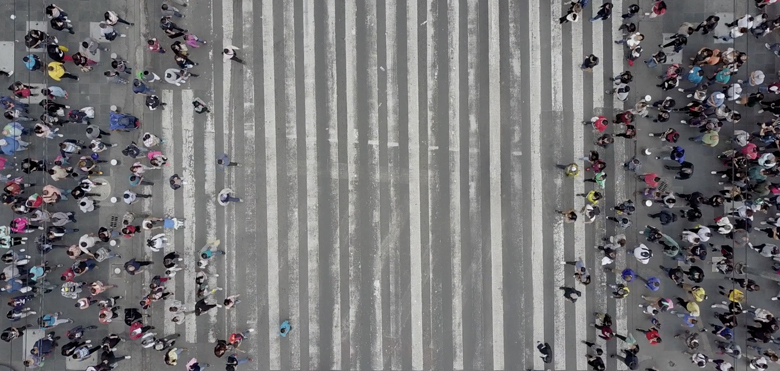How panoramic and PTZ cameras add value in cities
Imagine being in a busy city square and an incident occurs in the far corner. You hear shouting and perhaps see a scuffle, but would you be able to provide accurate details of what happened based on your view? Chances are that there are some elements that you missed due to the distance, obstructions to your line of sight and limited ability to discern details.
Law enforcement officers face the same challenges when monitoring for incidents, yet maintaining the safety and security of residents remains a key objective for city officials. This can be difficult to achieve as urban centres are by nature complex environments to monitor, due to the high level and variety of activity. Also, multiple incidents can occur within the same time frame, making it impossible to be in all places at once.
Local security teams lack the resources to have ‘eyes and ears’ in all places and rely heavily on technology to monitor areas and provide details on incidents. Panoramic and Pan-Tilt-Zoom (PTZ) cameras are key parts of a surveillance solution and there are a number of use cases where they add value.
Panoramic and PTZ cameras bring different attributes to the table
Before diving into the many use cases for these cameras in practice, it’s important to recognize the key differences between them:
- Single-sensor panoramic camera
As the name suggests, these cameras have one sensor and tend to be more suitable for smaller indoor areas such as shops or lobbies. The field of view will be determined by where it is mounted. For example, when mounted on the ceiling these cameras provide a 360-degree view of the area to be monitored. This large overview also provides good image quality allowing you to spot and proactively deal with undesirable behavior within your small space.
In addition, even though the camera uses a fisheye lens, thanks to dewarping technology, the image will look very natural and not distorted. Alternatively, these cameras can be mounted on walls, providing a 180-degree view at face level to support identification of suspects if an incident occurs.
- Panoramic multisensor cameras
Panoramic multisensor cameras consist of three or four sensors, which together covering 180-degree horizontal and up to 90-degree vertical areas. This creates a wide angle, seamless image in much greater detail, even at longer distances, with minimal distortion and no blind spots. Security and safety can often be tricky in situations such as busy town squares, parking lots and stadiums where there is a lot of movement in a wide area. The better image quality at longer distances makes panoramic cameras extremely useful in situations where incidents can happen far away. Also, due to the multiple sensors, the functionality needed is contained within one camera, as opposed to many within the same area. The single camera only requires one license, one cable, and one IP address which can drastically lower your costs.
- Multidirectional cameras
In some multisensor cameras, different sensors can face different directions to gain maximum coverage. These devices have separate streams with individual viewing angles – using two or four individual camera heads. When spaced evenly the sensors can cover up to 360-degrees, but can also overlap each other to create more zoomed in coverage through one sensor. Multidirectional cameras can also be positioned on the ceiling, so that the sensors can monitor different directions. You will have clear and detailed views of any foot traffic to maximize the overview and spot any security issues that may be developing.
- PTZ cameras
These are mainly used to provide zoomed in images and can be manually controlled by an operator or set up to automatically focus on things defined in your video analytics software. They provide detailed images allowing identification and classification of objects, especially in high risk areas such as around ATMs and building exits. Operators can ‘click-in-image’ to direct the camera to an area of interest to get a close up of an incident. This will help reveal critical details to support investigations.
Combining both panoramic and PTZ cameras allows for maximum coverage and zooming capabilities in one solution. These cameras provide real-time monitoring and zero blind spots, which is ideally suited for city surveillance. This configuration also allows you to utilize high quality images to support investigations following an incident.
Cameras in action – from dark alleyways to busy metro stations
Now that you’re familiar with the attributes of different types of cameras, it’s important to know which use cases best play to their strengths. It’s important to remember that in addition to the high level of activity, each area within a city has its own surveillance needs. For example, a metro station at rush hour will require a different level of monitoring than a quiet alleyway at midnight. In both scenarios, you need a surveillance solution which helps you capture what’s happening – with no blind spots – alerts you to any activity of interest and arms you with the information you need to investigate further.
Consider an ATM situated in an alleyway with limited lighting. Although it is a low traffic area, you are already aware that it is high risk for criminal activity. To effectively monitor this area, you can position a panoramic camera to cover the whole alleyway and add a PTZ camera positioned to focus on the ATM. Additional software can be used to improve activity detection, such as a directional audio detector. If an incident occurs, the software could send you an alert requesting to direct your attention to the alleyway. This gives you the chance to intervene and capture the incident for later analysis or evidence
On the other end of the spectrum, think about a busy train station at rush hour. Trains are continuously arriving and unloading hundreds of commuters onto the platforms. In this case, you need wide coverage with no blind spots in case an incident or multiple incidents occur. Multi-directional cameras may be a good choice to support you in monitoring activity. The coverage allows images to be captured from different areas – all from one camera.
Finally, consider a small shop – in this case, a combination of a single sensor panoramic camera positioned on the ceiling along with a PTZ pointed at the cash register may be the most useful. In this way activity across the shop can be captured – even in the furthest aisles – and high-risk areas such of the cash register be closely monitored.
Unlocking the value of panoramic and PTZ cameras
Cities represent a combination of different environments with varying needs. Maintaining the safety and security of residents is of primary importance and video surveillance is a key part of that. Having access to various types of cameras with different attributes can help satisfy the full range of your unique use cases and support law enforcement in their activity. It’s also important to note that combining cameras with different capabilities can reduce total cost of ownership and increase return on investment. This is key in a smart city context, where the benefits of investments in technology must be apparent and support objectives.
As the city landscape evolves with time, it will become increasingly important for have a surveillance system which is able to respond to new use cases as they arise. By understanding what the different types of cameras bring to the table, you will be equipped to respond and implement the right combination and configuration of technology to support your desired outcomes, regardless of required need.
Find out more about Axis Panoramic and PTZ cameras here:




